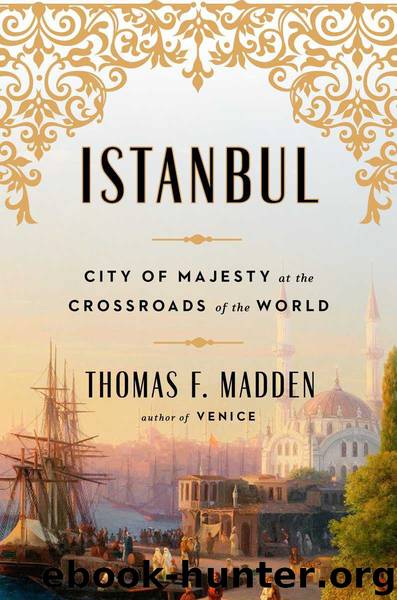Istanbul: City of Majesty at the Crossroads of the World by Madden Thomas F

Author:Madden, Thomas F. [Madden, Thomas F.]
Language: eng
Format: epub
Publisher: Penguin Publishing Group
Published: 2016-11-21T16:00:00+00:00
Chapter 14
Latin Occupation
U nthinkable is precisely the word to describe the fall of Constantinople. Armed rebellions, palace coups, bloody riots—these were regular, even expected events in the lives of Constantinople’s people in 1204. Yet none had ever tarnished the luster of the greatest city in the known world. True, the hated Westerners had breached the walls, but they had done the same one year earlier, when they ousted Emperor Alexius III and placed his brother and nephew on the throne of the caesars. To replace an emperor was the reason all armies in the last several centuries had made war on Constantinople. If the attempt was successful, the winner protected his newly won capital. He had every reason to do so.
Since the days of the rebellion of Alexius I Comnenus in 1081, the response in Constantinople to a successful military attack on the city was always to shift the capital’s allegiance to the victor. That was infinitely preferable to hosting a destructive war across the vast urban landscape. It was commonly accepted that an emperor who could not defend Constantinople was simply unworthy of it. As the shadows lengthened on the evening of April 12, 1204, the city’s hundreds of thousands of residents prepared to welcome their new victorious emperor. Mourtzouphlus’s short reign was over.
Mourtzouphlus disagreed, naturally. He knew well that the Crusaders had not yet conquered Constantinople. Some twenty thousand of them had entered the city and made camp in the northern region left barren by the Venetians’ fires of the previous spring. One of their leaders, Baldwin of Flanders, had occupied Mourtzouphlus’s colorful tent at Pantepoptes monastery—a symbolic gesture. Mourtzouphlus and the Crusade leaders understood that there was much more to conquering Constantinople. The Western knights needed broad, open spaces on which to charge their horses. They were nearly useless in the densely packed streets of Constantinople’s core, and Crusade leaders had already forbidden their soldiers from venturing into the city’s snarl of backstreets and broad avenues, where they could easily be picked off by lone assassins, tumultuous mobs, or residents throwing down roof tiles. Instead, they would post guards overnight and, on the morrow, draw up their battle ranks in the open, burned region. There they would demand that Mourtzouphlus meet them on the field of honor. If he refused, they would set fire to the city, burning out its defenders.
A few renegade Crusaders decided to employ that strategy early. That night, they set fire to buildings along Constantinople’s northern seawall. The fire spread quickly to the east, along the lower elevations, stopping only when it reached the charred desolation left behind by the great fire of the previous August. This was the third fire the Crusaders had inflicted upon Constantinople. Geoffrey de Villehardouin estimated that more houses were destroyed in the three blazes than existed in the three largest cities in France. He was close to the mark. Altogether the Crusaders had turned one-sixth of Constantinople into smoldering ruins and eliminated one-third of its dwellings. Looking
Download
This site does not store any files on its server. We only index and link to content provided by other sites. Please contact the content providers to delete copyright contents if any and email us, we'll remove relevant links or contents immediately.
China Rich Girlfriend by Kwan Kevin(3900)
The Silk Roads by Peter Frankopan(3772)
Annapurna by Maurice Herzog(2845)
Hot Thai Kitchen by Pailin Chongchitnant(2815)
Full Circle by Michael Palin(2780)
Okonomiyaki: Japanese Comfort Food by Saito Yoshio(2391)
City of Djinns: a year in Delhi by William Dalrymple(2138)
The Ogre by Doug Scott(2118)
Photographic Guide to the Birds of Indonesia by Strange Morten;(2091)
Tokyo by Rob Goss(2022)
Vietnam, Cambodia, Laos & Northern Thailand by Lonely Planet(2016)
Tokyo Geek's Guide: Manga, Anime, Gaming, Cosplay, Toys, Idols & More - The Ultimate Guide to Japan's Otaku Culture by Simone Gianni(1949)
Discover China Travel Guide by Lonely Planet(1868)
Everest the Cruel Way by Joe Tasker(1829)
China (Lonely Planet, 11th Edition)(1799)
Lonely Planet China(1758)
China Travel Guide by Lonely Planet(1741)
Top 10 Dubai and Abu Dhabi by DK Travel(1718)
Iranian Rappers And Persian Porn by Maslin Jamie(1712)
